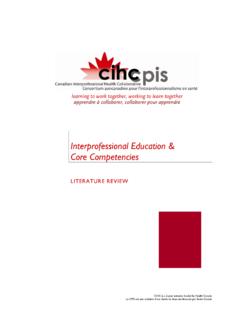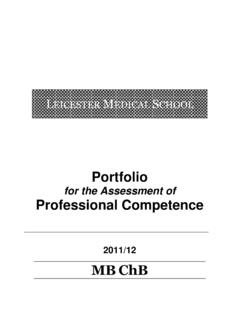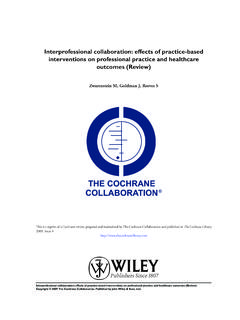Transcription of IPE Six Case Studies - World Health Organization
1 Human Resources for Health ObserverInterprofessional collaborative Practice in Primary Health Care: Nursing and Midwifery PerspectivesSix case StudiesIssue no 13 interprofessional education and collaborative practice can play a significant role in mitigating many challenges faced by Health systems around the World . As professionals, nurses and midwives work is largely directed towards care. To be effective, teamwork is critical. A greater understanding of the barriers and possible solutions for interprofessional education and collaborative practice is essential. This document discusses collaborative practice through the lens of primary Health care. The document begins by outlining what the literature reveals and presents six case Studies which show that there is growing importance of interprofessional education and collaborative practice as a means of strengthening Health care provision. However, to adequately demonstrate its effectiveness further research is required.
2 This publication is available on the internet at: 978 92 4 150585 7 IPE 2-303/07/2013 08:30 WHO Library Cataloguing-in-Publication DataInterprofessional collaborative practice in primary Health care: nursing and midwifery perspectives: six case Studies .(Human Resources for Health Observer, 13) Health care. behavior. relations. reports. Health Organization . ISBN 978 92 4 150585 7 (NLM classification: W ) World Health Organization 2013 All rights reserved. Publications of the World Health Organization are available on the WHO web site ( ) or can be purchased from WHO Press, World Health Organization , 20 Avenue Appia, 1211 Geneva 27, Switzerland (tel.: +41 22 791 3264; fax: +41 22 791 4857; e-mail: Requests for permission to reproduce or translate WHO publications whether for sale or for noncommercial distribution should be addressed to WHO Press through the WHO web site ( ).)
3 The designations employed and the presentation of the material in this publication do not imply the expression of any opinion whatsoever on the part of the World Health Organization concerning the legal status of any country, territory, city or area or of its authorities, or concerning the delimitation of its frontiers or boundaries. Dotted lines on maps represent approximate border lines for which there may not yet be full mention of specific companies or of certain manufacturers products does not imply that they are endorsed or recommended by the World Health Organization in preference to others of a similar nature that are not mentioned. Errors and omissions excepted, the names of proprietary products are distinguished by initial capital reasonable precautions have been taken by the World Health Organization to verify the information contained in this publication. However, the published material is being distributed without warranty of any kind, either expressed or implied.
4 The responsibility for the interpretation and use of the material lies with the reader. In no event shall the World Health Organization be liable for damages arising from its use. Layout by L IV Com S rl, Villars-sous-Yens, by the WHO Document Production Services, Geneva, 4-503/07/2013 08:30 interprofessional collaborative Practice in Primary Health Care: Nursing and Midwifery PerspectivesSix case StudiesIPE Six case 103/07/2013 08:33iiAcknowledgementsWe thank the following key informants for their timely responses and most helpful cooperation throughout this study: Regina Witt, Brazil; Steve Patterson, Canada; Ainsley Moore, Canada; Tomi Thomas, India; Dan Mwesigwa-Kayongo, South Africa; Marian Novak, work was carried out by Frieda Chavez, Director, Global Affairs Office, Bloomberg Faculty of Nursing, University of Toronto, Canada in collaboration with the World Health project was conceived and coordinated by Annette Mwansa Nkowane, Technical Officer, Human Resources for Health (Nursing and Midwifery), World Health Organization , Geneva, Six case 203/07/2013 08:331 ContentsAcronyms 2 Executive summary 31.
5 Background 42. What the literature shows interprofessional education and collaborative practice Barriers to interprofessional education and collaborative practice 5 Professional cultures and stereotypes 5 Inconsistent use and different understandings of language 6 Accreditation and curricula 6 Knowledge of the roles and scope of other Health professions 63. Key enablers for interprofessional education and collaborative practice Leaders and champions Administrative, institutional and work culture support Mentorship and learning Shared vision or mission Physical environment and space design 84. The case Studies Methodology Limitations 95. Description of case Studies Porto Alegre, Brazil Edmonton, Alberta, Canada Hamilton, Ontario, Canada Andra Pradesh, India Eastern Cape Province, South Africa Philadelphia, PA, USA 126. Discussion Summary of enablers in case Studies Summary of barriers in case Studies Guiding principles for developing interprofessional education and collaborative practice Suggested further research 15 References 16 IPE Six case 103/07/2013 08:332 AcronymsCHAI Catholic Health Association of India CP collaborative practiceIPCLUs interprofessional Clinical Learning UnitsIPE interprofessional educationPHC primary Health careWHO World Health OrganizationIPE Six case 203/07/2013 08:333 Executive summaryThere is increasing interest in the ability of Health -care professionals to work together, and in understanding how such collaborative practice contributes to primary Health care (PHC).
6 interprofessional education drives the need to identify and establish enabling mechanisms for collaborative practice in PHC. This study examines six PHC practice settings from both resource-constrained and resource-rich countries in order to identify not only the enabling mechanisms that facilitate collaborative practice to support PHC, but also barriers to such practice. The World Health Organization s Framework for Action on interprofessional education and collaborative Practice was used to examine the mechanisms that shape interprofessional education , collaborative practice, and Health and education systems. Findings are consistent with the growing body of literature on enabling mechanisms for and barriers to interprofessional education and collaborative practice. The study concludes with a discussion of policy and practice implications and recommendations for future research. Based on this work, it is clear that inteprofessional education and collaborative practice are closely Six case 303/07/2013 08:3341 BackgroundHealth system reforms based on the principles of primary Health care (PHC) have become a major challenge for policy-makers, Health workers and leaders across the globe.
7 The World Health Organization (WHO) defined PHC in 1978 as essential Health care based on practical, scientifically sound and socially acceptable models and technology made universally accessible to individuals and families in the community through their full participation and at the cost that the community can afford to maintain at every stage of their development in the spirit of self-reliance and self-determination. collaborative practice (CP) has been identified as a promising means of strengthening Health systems and improving Health outcomes. Such collaboration is increasingly regarded as important for Health systems worldwide to meet complex Health needs given the limited human and financial resources (Mickan et al. 2010; Reeves et al. 2009). There is now sufficient evidence to conclude that effective interprofessional education (IPE) enables effective CP (Blackwell et al. 2011; Frenk et al. 2010; Reeves et al.)
8 2009; Yan et al. 2007). WHO defines IPE as students from two or more professions learn[ing] about, from, and with each other to enable effective collaboration and improve Health outcomes (WHO 2010, p. 13). interprofessional education can transform Health professional education , which is currently fragmented and outdated with a static curriculum that fails to equip graduates adequately for CP (Frenk et al. 2010). The World Health Organization (2010) defines interprofessional CP as multiple Health workers from different professional backgrounds working together with patients, families, caregivers and communities to deliver the highest quality of care (ibid.). The WHO Framework for Action on interprofessional education and collaborative Practice (2010) offers strategies to help Health policy-makers implement the elements of IPE and CP that will benefit their Health systems in their individual country contexts.
9 This Framework reflects the fragmentation inherent in many Health systems worldwide and the challenges posed to the Health workforce by increasingly complex Health issues. Evidence shows that as Health workers move through the system, interprofessional experience offers them the necessary skills to become part of a collaborative , practice-ready Health workforce. A collaborative practice-ready workforce is one in which Health workers have received effective training in IPE (WHO 2010, p. 10) enabling them to enter the workplace as members of a CP number of mechanisms shape how IPE is developed and delivered. The WHO Framework for Action on interprofessional education and collaborative Practice groups these mechanisms into two categories: educator mechanisms (for academic staff, training, champions, institutional support, managerial commitment and learning outcomes) and curricular mechanisms (concerning logistics and scheduling, programme content, compulsory attendance, shared objectives, adult learning principles and contextual learning) (WHO 2010, p.)
10 12). Other mechanisms shape how CP is introduced and executed. Examples of these mechanisms are divided into three categories: institutional support mechanisms (concerning governance models, structured protocols, shared operating resources, personnel policies, supportive management practices ); working culture mechanisms (for communication strategies, conflict resolution policies, shared decision-making processes); and environmental mechanisms (on the built environment, facilities, space design). Once a collaborative , practice-ready Health workforce is in place, these mechanisms help decision-makers to identify the actions that will support CP. This document beginning by presenting information on IPE and CP based on the literature review and then highlights specific case Six case 403/07/2013 08:3352 What the literature showsThis report outlines six case Studies . The starting point for these was an extensive literature review to identify key issues for IPE and/or CP, including barriers and potential solutions.















